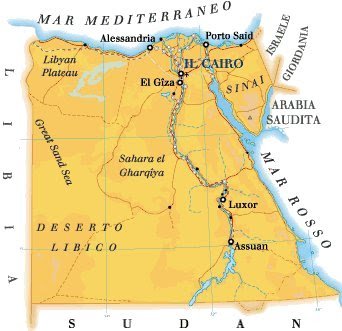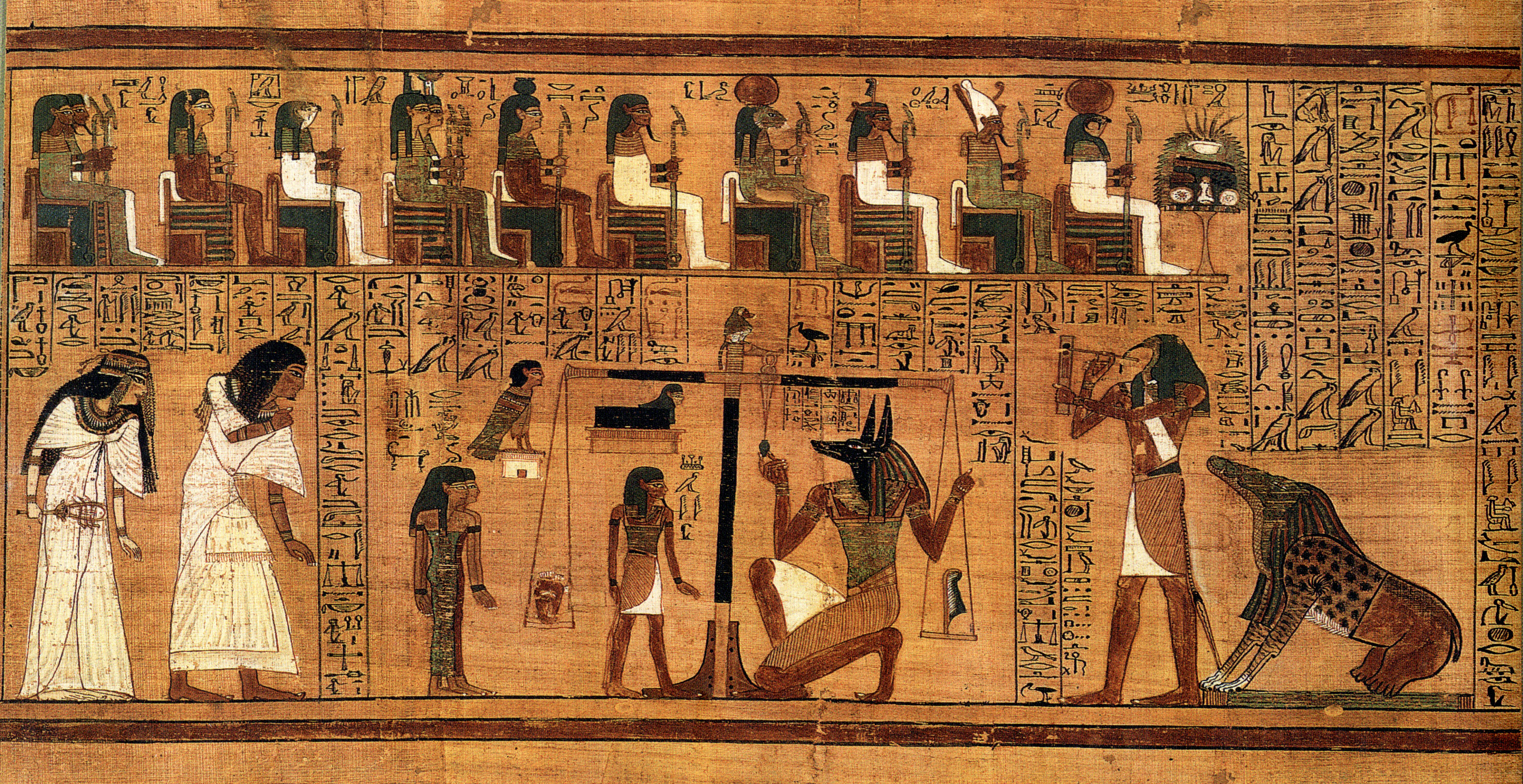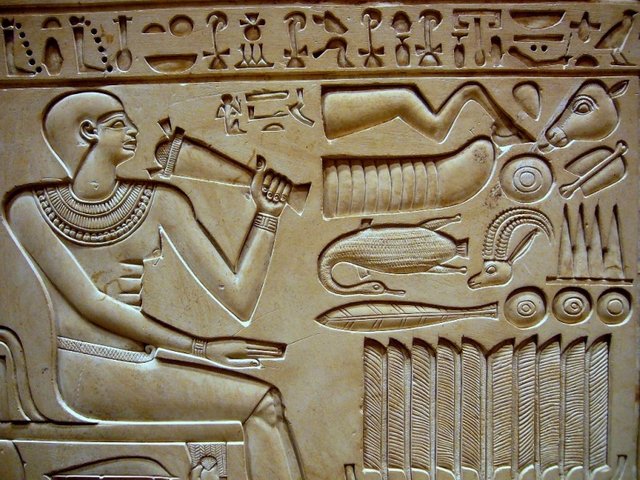Red earth and black earth.
The civilization of ancient Egypt owes its wealth to the waters of the Nile River, which crosses from north to south the eastern edge of the Sahara desert, called Tierra Rojas. The area is more than a thousand kilometers long, by 20 or 30 wide, which extends up to 250 in the delta of the mouth. Every year, from June to September, the floods flood the fields located on both banks of the river. When the waters are removed in November, they have deposited sediments and silt, and the soil, called Tierra Negra, is fertilized. To optimize river resources, the Egyptians built irrigation canals and containment barriers.

The Upper Egypt.
Originally, around 3000 BC, Egypt was made up of two completely separate kingdoms, Upper Egypt and Lower Egypt. These two territories had different climate, habitat and customs. Upper Egypt, to the south, owes its name to the upper course of the Nile River. It extends from Aswan to Memphis, and is formed by a narrow valley. Hieracómpolis was its capital and God more adored was Set. In Upper Egypt you will find the Valley of the Kings and the Valley of the Queens, as well as the temples of Karnat and Luxor. It was his most outstanding city.

The Lower Egypt.
The region of the Lower Nile corresponds to the north of Egypt and is formed by the area of the lower course of the Nile and the Broad Delta that forms its mouth. It is the richest region from the agricultural point of view, but since it is a marshy area it needs many hydraulic works of containment and channeling of the waters. The villages had to be built in elevated areas to protect them from the impetuous floods of the waters; This explains their dispersed habitat. In this region, livestock was very important. In Lower Egypt, whose capital was Buto, the classical Egyptian triad was worshiped (Osiris, Horus and Isis). In this region you will find the famous pyramids of Gizeh. The most important cities were Memphis, Heliopolis and Tanis, and later, Alexandria.

The first Pharaohs.
Upper and Lower Egypt were Unified by 3100 a.C. by King Menes, who is considered the first pharaoh of Egypt and who installed the capital of the Kingdom of Memphis. During the Ancient Empire 2707-2170 BC, Egypt became a great state. In this period the territorial expansion occurred south of the second cataract and military expeditions were undertaken to Nubia and Libya. Maritime trade in the eastern Mediterranean was also promoted and the Sinai mines explored. The monarchs had an absolute power that was based on the Theocratic system. The most outstanding pharaohs were Zoser, Keops, Kefrén and Micerinos.

The dynasties of the Pharaohs.
A dynasty is a series of kings who belong to the same family. From the end of 4000 a.C. until the 4th century BC, until the 4th century. a.C., and for more than three thousand years, Egypt had a long history as an independent state in which 31 dynasties happened, the majority being autochthonous. These dynasties were grouped into various stages: the Archaic Period (between 3100 and 2707 BC), from Dynasty III to IV; the Middle Kingdom 2119-1793 BC, from XI to XII; the New Empire (1550-1067 a.C) from the XVIII to the XX; and the late period (1069-332 a.C) from XXI to XXXI. Between one empire and another there were periods of instability, denominated for intermediate periods.

The Middle Kingdom
After a period of conflict and disintegration of power, the King of Thebes Mentuhotep II managed to reunify Egypt and maintain peace. Then began the Middle Kingdom 2119-1793 that comprises of the XI and XII dynasties. At first, the nomarcas maintained a high degree of autonomy but then the pharaoh, with the support of the priests of Amón, restored the central power. The Middle Kingdom was a time of splendor, in the economic and cultural aspect, as manifested in architecture and literature. But between 1986 and 1567 a.C. a new disintegration of the state took place, which favored the invasion of the Hyksos.

The New Empire
Overcoming the domination of the Hyksos, from Egypt the reunification of Egypt was initiated and the XIII dynasty was inaugurated, inaugurating the new period 1550-1069 a.C. The central power controlled the nobility and initiated a territorial expansion abroad. It is Tutmosis III and Ramses III. At the end of the period, Egypt was losing conquered territories, while in the interior of the country, nobles and priests hoarded wealth in the middle of a generalized situation of poverty, which diminished the prestige and power of Pharaoh.

The end of Ancient Egypt.
During the first millennium before Christ and until the conquest of Alexander the Great, Egypt experienced a period of decadence and internal conflicts. The pharaohs ruled from Tanis they clashed with the priests of Thebes. The kingdom was occupied and ruled, successively by Libyans, Ethiopians, Assyrians, Persians. Egypt reasserted its independence in a timely manner and last was the XXX- In 332 BC, Egypt was occupied by Alexander Mago, who founded Alexandria. After his death, General Ptolemy ruled the country and in 305 a.C. He assumed the title of king. In 31 a.C. Egypt became a province of the Roman Empire.

The Egyptian art.
The cult to the gods and the beliefs on the outer life impregnates all the manifestations of the Egyptian art especially to its architecture, limited to a religious and funerary purpose (temples and tombs), because it is granted greater importance to the dwelling of the dead than the residence of the living. This desire to build eternal constructions and produce the impression of being by means of volume and mass is the inspiration of his aesthetic works. The monumental grandiosity, the mathematical rationalism and the tendency to symbolism are some of the most pronounced features of Egyptian art.

Sculptures for the beyond.
The sculptures that represent the gods and the pharaohs show absolute rigidity. The appearance of the farón is solemn and the features of the face are idealized, since it was considered that a sacred image was outside the laws of time. The figure always appears in profile: The arms are attached to the body and one of the legs advances without abandoning the usual stiffness. On the other hand, the statues of the secondary characters, such as the scribes or officials, are made with surprising naturalism: this is demonstrated by the seated Scribe and the so-called Mayor of the town.
The paintings of the tombs.
In Egyptian painting, the way of drawing the figures was not absolute realistic, if not rather schematic. The images did not intend to portray the character as it appears in earthly life; on the contrary, they tried to capture its essence, which, according to the Egyptians, lasted after death. The artists, therefore, painted based on a code of precise rules that remained unchanged for centuries. They always portrayed the body in profile, but the men, the bust and the eye appeared in frontal position. In terms of space, the Egyptian artist did not represent it as he saw it in reality, nor did he try to create depth effects through perspective, but instead he arranged all the figures and objects on a single plane parallel to the observer.

Colossal Constructions
The pharaohs wanted to build eternal works and pass to posterity as their inspirers. To achieve this, they used stone to build the most significant buildings: the temples and the tombs, both based on the lintel system with tall and robust columns, that is, without arches or vaults. The earliest form of burial is the mastaba, a truncated pyramid shaped tomb. The mastabas superposition gives rise to the stepped pyramid; Later, the blocks of the cladding are filled, giving rise to the impressive pyramids with a solid square base that we know as Giza pyramids. The Egyptian temples (Luxor, Kanark) were formed by rectangular patios surrounded by towering colonnades, through which a covered construction was accessed.

Egyptian pyramids.
I usually publish issues of literature, biographies, art, music, philosophy, history, and any subject of deep culture; Follow me if you want to see more of my publications and comment if you want to continue publishing more topics of this type.Thank you very much, and see you soon!

Dear friend! Next time also use #artzone and follow @artzone to get an upvote on your quality posts!
Downvoting a post can decrease pending rewards and make it less visible. Common reasons:
Submit
Dear friend! Next time also use #artzone and follow @artzone to get an upvote on your quality posts!
Downvoting a post can decrease pending rewards and make it less visible. Common reasons:
Submit
You got a 9.16% upvote from @redlambo courtesy of @siruniversalis! Make sure to use tag #redlambo to be considered for the curation post!
Downvoting a post can decrease pending rewards and make it less visible. Common reasons:
Submit
You got a 16.67% upvote from @childfund courtesy of @siruniversalis! @childfund is a bid bot to help the steem community sponsor a child.
Downvoting a post can decrease pending rewards and make it less visible. Common reasons:
Submit
Downvoting a post can decrease pending rewards and make it less visible. Common reasons:
Submit
Congratulations! You got 66.67% upvote from @lightningbolt, Thanks to @siruniversalis! Enjoy!
Downvoting a post can decrease pending rewards and make it less visible. Common reasons:
Submit